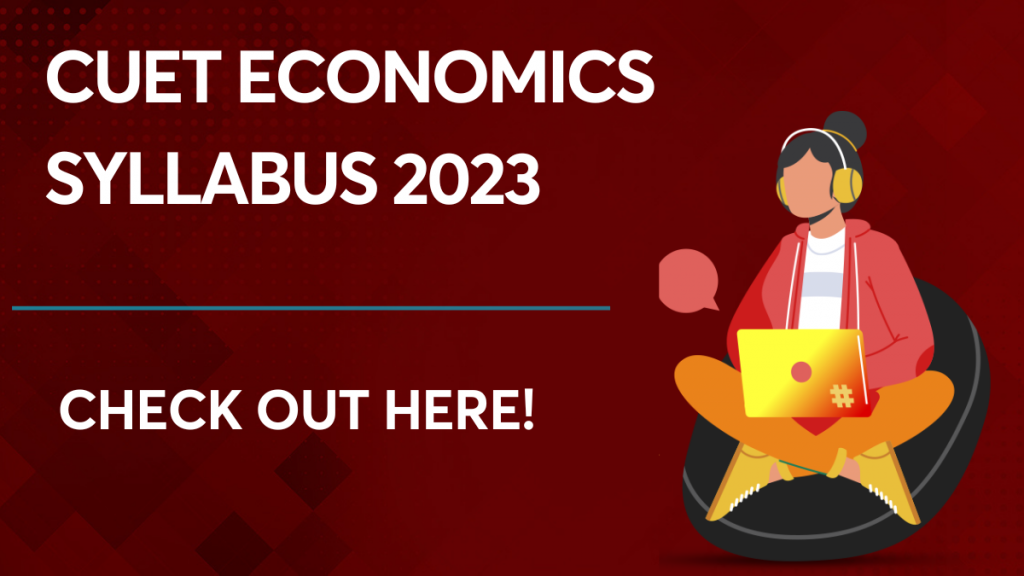Are you looking to take the Common University Entrance Tests (CUETs) Economics syllabus in 2023 and need to know what to expect? You’ve come to the right place! In this blog, we’ll be outlining the different topics that will be covered in the CUET Economics syllabus 2023. From macroeconomics, Introductory Macroeconomics, Indian Economic Development and more, this article will give you all the information you need to prepare for your upcoming examination. So keep reading if you want to ace your entrance test and get into your dream university!
CUET Economics Syllabus 2023
The CUET Economics Syllabus covers a wide range of topics related to the economy. The syllabus is available in both Hindi and English on the official website. The students can also download the CUET Economics Syllabus PDF in Hindi and CUET Economics Syllabus PDF English from here. The syllabus covers topics like macroeconomics, Introductory Macroeconomics, Indian Economic Development and more. The CUET Economics Syllabus for 2023 is given below the table:
|
CUET Economics Syllabus 2023 |
|
|
Subject |
Topics |
|
Economics |
Unit I: Introduction to Microeconomics
Unit II: Consumer Behaviour and Demand
Unit III: National Income and Related Aggregates — Basic Concepts and Measurement
Unit IV: Determination of Income and Employment
Unit V: Money and Banking
Unit VI: Government Budget and the Economy
Unit VII: Balance of Payments
Unit VIII: Development Experience (1947-90) and Economic Reforms since 1991
Unit IX: Current challenges facing the Indian Economy Poverty: absolute and relative; Main programmes for poverty alleviation: A critical assessment; Human Capital Formation: How many people become resource; Role of human capital in economic development; Rural development: Key issues: credit and marketing – role of cooperatives; agricultural diversification; Employment: Growth and changes in work force participation rate in formal and informal sectors; problems and policies Infrastructure: Meaning and Types: Cases Studies: Health: Problems and Policies – A critical assessment; Sustainable Economic Development: Meaning, Effects of Economic Development on Resources and Environment, including global warming Unit X: Development Experience of India
|
CUET Economics Books – Expert Recommended
There are a few things to keep in mind while picking the right book for your CUET Economics preparation. First and foremost, make sure the book covers the entire syllabus of the course. Secondly, it is always better to read expert-recommended books as they give you an insight into what to expect in the exam. Here is a list of some of the best books for CUET Economics that our experts recommend:
| Book | Publishers |
|---|---|
| Basic Economics | DN Gujarati |
| Mathematics for Economics | Sydsaester & Hammonds |
| NCERT Economics Textbook (Class XI and XII) | NCERT |
| CUET Entrance Exam for Economics | Sourav Sir’s Classes (Kolkata & New Delhi) |
| Intermediate Microeconomics | Hal R Varan |
CUET Economics Preparation Tips
There are a few Preparation Tips students can use when preparing for their CUET Economics Syllabus:
Understand the Economics Syllabus: One of the most important CUET Economics preparation tips is to get a good understanding of the syllabus for the course. The syllabus will outline all of the topics that will be covered on the exam, so it is essential that you are familiar with all of the material before taking the test.
Review Previous Economics Exams: Another great way to prepare for your upcoming CUET Economics exam is to review previous exams. This will give you a good idea of what types of questions are typically asked on the test. Additionally, reviewing past exams can help you identify any areas where you may need additional study.
Use Practice Tests: In addition to reviewing previous exams, another great way to prepare for your CUET Economics exam is to use practice tests. These tests can help you get a feel for the format of the exam and can also help you identify any areas where you need additional study.
Make a Study Plan: Once you have a good understanding of the material that will be covered on the exam, it is important to make a study plan. This plan should include when and how often you will study, as well as what resources you will use. Additionally, it is important to set realistic goals for yourself so that you do not become overwhelmed with studying.
CUET Economics Syllabus 2023: 5 FAQs
The common university entrance tests (CUETs) are a set of exams required for admission to undergraduate programs (UG). The tests are designed to assess academic skills and knowledge in specific subject areas.
The economics syllabus for the CUETs covers introductory microeconomics and macroeconomics, as well as specific economic topics relevant to the field of study. The aim of the syllabus is to provide students with a strong foundation in economic theory and principles, which will prepare them for further study in economics at the university level.
There are a number of ways to prepare for the CUETs, including attending a preparatory course, studying independently, or hiring a tutor. Consult your local university or college for more information on how to best prepare for the exams.
To download the syllabus PDF, students should visit the official website.
The last date to apply for the CUET exam 2023 is 12/03/2023.
